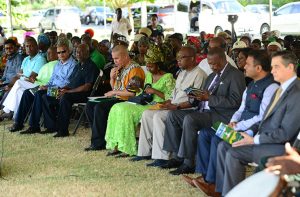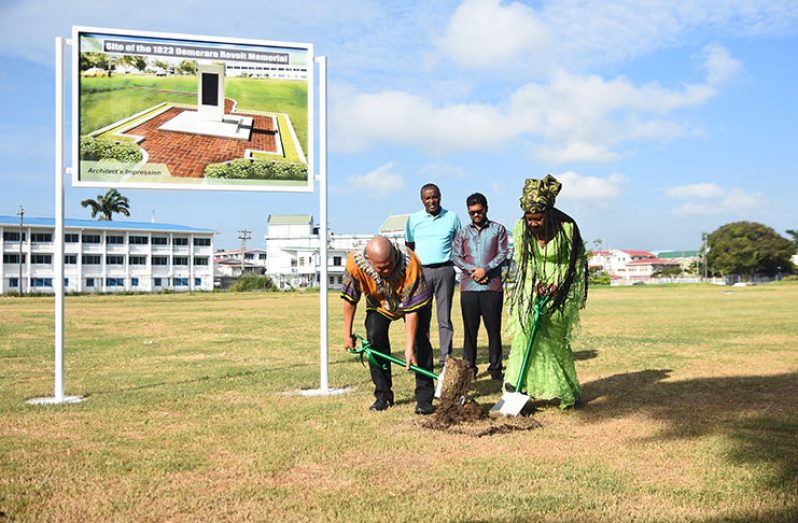MEMBERS of the African community in Guyana are overjoyed that the sod has officially been turned for the erection of an 1823 memorial in memory of those who lost their lives during the 1823 Demerara Rebellion.

The monument will be erected at Parade Ground, which is located between Middle and Waterloo Streets, Georgetown and holds rich history of the aftermath of a peaceful rebellion for freedom.
Members of the government, the diplomatic corps, dignitaries and several Afro-groups gathered at the location on Sunday for an appreciation and sod-turning ceremony.
Groups represented included the International Decade for People of African Decent Assembly-Guyana (IDPADA-G); the Ghana Day Organisation; the Guyana United Apostolic Mystical Council (GUAMC); the 1823 Coalition of the Parade Ground Monument; the Pan African Movement –Guyana Branch; the Guyana Reparations Committee; the African Cultural and Development Association (ACDA) and the United Nations Association of Guyana.
Others in attendance were Minister of Social Cohesion, Dr George Norton; Minister within the Ministry of Social Protection, Keith Scott; Minister within the Ministry of Public Infrastructure, Jaipaul Sharma; Minister of Public Telecommunications, Cathy Hughes; Minister of Business, Haimraj Rajkumar; Speaker of the National Assembly, Dr Barton Scotland; Mayor of Georgetown, Ubraj Narine and former Mayor of Georgetown, Hamilton Green.
Sacred Ground
On August 18, 1823, a two-day uprising of over 10,000 enslaved Africans, led by those of the highest status amongst them, took place in the Crown Colony of Demerara-Essequibo.
The enslaved Africans were fuelled mainly by poor treatment and the deliberate withholding of information by the planters on England’s orders that immediate and effective measures be taken for the abolition of slavery throughout the British colonies.
The rebellion was deemed largely non-violent as the enslaved Africans tied up the whites, relieving them of their weapons and ammunition.

It was chiefly instigated by Jack Gladstone, a slave at the Success plantation; his father, Quamina Gladstone and other senior members of their church group, the Bethel Chapel of the London Missionary Society.
However, on August 20, 1823, the Africans were defeated by the colonial cavalry and over 200 were killed.
Following the rebellion, the government sentenced another 45 men to death and 27 were executed.
Many heads were placed on spikes and dead bodies were publicly displayed at the very Parade Ground which originally stretched from New Market Street to Quamina Street. It served as a means to discourage other enslaved Africans from rebelling against their masters.
Meanwhile, Quamina, who is thought to have been the actual leader of the rebellion, was declared a national hero after Guyana gained independence.
Streets have been named and monuments have been erected in his honour in Guyana’s capital city, Georgetown.
President of the Ghana Day Organisation, Sister Penda Guyan and others believe that placement of the monument at the ground acknowledges the right of those who brutally lost their lives to have their wandering spirits be laid to rest, knowing that the whole truth of the rebellion will be told.
Addressing the attendees, Minster Norton stated that while there is already an 1823 Monument located opposite the Guyana Defence Force’s (GDF) Headquarters, President David Granger found it necessary to support the calls of historians and others for the Parade Ground location to bear indication of its history.
“The erection of a monument at this fitting location will honour the sufferings of our African foreparents, as it reminds us that the freedom we experience today came at an incalculable price,” Dr. Norton said.

“All Guyanese are the beneficiaries of the men, women and children who resisted with arms and with other actions. We must therefore value their memory and use our time wisely and constructively. I believe that young Guyanese — particularly those of African descent — must see these dreadful aspects of our country’s history as a motivation to strive for greatness,” he added.
Broken Promise
Plans for the erection of the memorial have been in the pipeline for many years, former City Mayor Hamilton Green and Sister Guyan said.
Speaking with reporters on the sidelines, Sister Guyan recounted: “On this very ground, on August 1, 2000, the then President of this country, Mr. Jagdeo, turned the sod here with Ms. Gail Teixeira — who at the time [was] the Minister of Home Affairs — and they buried coins vowing with they would be a monument put here. However, when we were ready, we were told that they were looking for a site to put the monument and we couldn’t understand this… [but it] was all to give this here to a particular entity to put a three-storey car park.”
Sister Guyan also recalled that when it was time for construction of the 1823 Memorial, now placed opposite the GDF headquarters, African groups were told that the ground —which can hold the monument many times over— was not large enough for it.
Sister Guyan is also a member of the 1823 Coalition of the Parade Ground Monument, a group which had protested for the relocation of the monument since the non-realisation of the promise.
During the programme, Green referred to the retraction of the promise by the former administration as “an insult to every Guyanese.”
Nonetheless, on behalf of IPADA-G, Chief Executive Officer Olive Sampson expressed gratitude to President David Granger and his administration for their kept promise to bring about a change which reflects the selfless efforts of Guyana’s African ancestors.
“Every Guyanese passing here must remember what it took for us to achieve the freedoms that we have today. Also, in recognising and remembering that, they must know that freedom is very precious and that it can be easily taken away, so we have to be vigilant and part of that vigilance is honouring and knowing the past,” she stated.

Meanwhile, Chairman of the Guyana Reparations Committee, Dr. Eric Phillips, told the Guyana Chronicle that later in the year he will be visiting London in a bid to retrieve three letters Quamina wrote to the London Missionary Society which are not within Guyana’s history books.
Quamina was a deacon of the Missionary Society, which has since acknowledged that it was complicit in the crime of slavery, and as such, now aims to take a resolution to its board to contribute $10M pounds as reparation.
Dr Phillips hopes that some of this money, should it be acquired, might be used to build a Quamina House which would house the Guyana Reparation Committee and artifacts of the 1823 Rebellion.
The ceremony on Sunday also featured the performance of a libation in honour of President David Granger and the country’s African ancestors, drumming and a poem from Kibwe Copeland.
The poem featured the words: “This ground holds history; this ground holds bloodshed; this ground holds tears; this ground is scared; this ground holds a story to remember and a sacrifice never, never to forget.”




.jpg)












